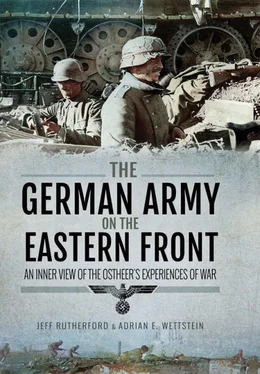While the mindful observer could already have recognized in the 1940 Western campaign that anti-tank defence was the Achilles’ heel of the German army, this proved relatively unimportant, as the Germans’ approach to the war rarely allowed for larger French or British tank actions to become dangerous. The invasion in the Soviet Union confronted German troops with even more modern tanks, such as the T-34 and the KV-1, but their tactically weak use and their relatively small numbers initially precluded a larger crisis on the German side. As their numbers rose and the German army was forced onto the defensive in the first winter, the weaknesses of German anti-tank defence became fully visible. The means presented ( Stielgranate , hollow charges to be put on the tanks, use of captured ATGs) were improvisational and/or demanded high skills. The deployment of heavy ATGs helped anti-tank defences, but demanded towing vehicles that were also needed by artillery or supply units. Self-propelled guns of the Marder class were a more effective measure, but it predictably took time to bring them to the frontline units. Even after more useful weapons such as the Panzerfaust , the Panzerschreck and diverse tank destroyers were available, from 1943 on, these would not fully fill the gap. Anti-tank defence remained a German vulnerability and it was one of the main causes of the ‘infantry crisis’ discussed later.
Steep angle fire weapons have a special importance for Army Group North, since it must be reckoned that we will probably face a long period of positional warfare. The troops do not need many sorts of things, instead, only a few types of heavy mortars. 8, 12 and 15cm with substantial ammunition because the Russian always rapidly and effectively digs in and then can only be fought successfully with effective steep angle weapons.
Discussions with other agencies and units went similarly, which are not described here. The further one goes down, the more that details were naturally debated. The troops’ interest in weapons was without exception great. This was especially true for the infantry regiments, which sensed through their losses that good weapons and ammunition are crucial for success.
The staffs, corps and divisions often had less interest, sometimes none at all. It was also noticed that even agencies that themselves need to pay attention to weapons effectiveness, not only failed to evaluate the weapons’ effectiveness correctly, but that they also even completely lacked the goodwill to concern themselves with such things. This is an evil that viewed in the long run, has to be described as dangerous and which must be necessarily suppressed.
This last section emphasizes how different perceptions of the war in the East emerged within the army’s hierarchy, depending on how close one was to the front line. Of course, soldiers in the front line would recognize deficiencies of weapons faster than army staffs or institutions in the Reich . This can be seen most obviously in the discussion about heavy mortars. Mortars were one of the primary weapons of the Eastern front and responsible for many losses. They were easier to produce and more often available to the troops than artillery, and were feared for their noiseless fire that allowed for effective surprise bombardments. With their excellent 12cm mortar, as well as with larger quantities of mortar shells, the Soviets had a distinct advantage. While there was, from late 1941 on, a strong demand for that weapon from the frontline troops who suffered from Soviet superiority in this area, central institutions occupied with that question did not seem to view it in the same urgent way. One should also be aware that the German stressing of ‘will’ as a key factor in battle success sometimes interfered with demands for better equipment, as that was seen as of secondary importance.
The following section of the report deals with artillery questions.
The effect of the [Soviet] 7.62cm [and] the 12.2cm guns and the 12cm mortar is judged as very good: the shells fragmented into many little splinters. The splinters of the 12cm mortar occasionally penetrate the German steel helmet and then cause light wounds. The shells of the heavy guns fragment less effectively, big splinters are frequent. All in all, the splinter effect of the Russian artillery is allegedly considerably better than in the [First] World War. The sensitivity of the fuses fully equals the requirements.
[…] While in the first months of the war the Russian often shelled only by batteries, he has now learned to concentrate the fire of a battalion or even several battalions. It has been observed in the Leningrad sector that Russian artillery surprisingly fired on one single target from positions in Leningrad, from the opposite coast, in Kronstadt and from the Oranienbaum [Lomonosov] cauldron. That is a noticeable achievement in terms of artillery and communications.
After the end of a year of war, Russian artillery also perfected the manoeuvrability of fire, the relocation of fire from one target to the other. Reconnaissance by sound [ranging] and subsequent combating of recognized fire positions is now the rule. The only thing the Russian has not yet mastered is fire by aerial observation.
With regard to mobility during the mission, the Russian artillery seems to be exemplary. It has often occurred that [Soviet] batteries that put our infantry and artillery under considerable fire were revealed by sound and air reconnaissance and then fired on by our own artillery. Immediately after fulfilling its mission, however, the Russian artillery had moved to an alternate firing position – as became apparent after the fact – and our fire hit an empty area. A Russian battery often had one main firing position and two alternate firing positions.
In contrast, our artillery is reproached for a lack of mobility. One Army Corps complained: ‘Our artillery cannot be moved by any power of the Earth to change positions. In the style of Erbhof farmers, it persists in its positions, embracing the principle: “Here I fire, here I stay, here I live, here I die!”’ The difficulties of the terrain, even those of the roads, as well as the lack of horses and other vehicles may partially, but not completely excuse that disinclination to move. This point is probably no longer stressed enough during training.
Almost all artillery regiments complained that the infantry approaches the artillery with all and every request concerning fire support and too little use is made of their own heavy weapons. Since the infantry, including the machine gun, infantry gun and ATG companies have higher losses than the artillery, in many cases there may exist a lack of appropriate low-level leaders. The artillery considers it possible to eliminate this dependence by subordinating the infantry’s artillery weapons to the artillery’s care.
Much is said about the guns in the individual reports. In summary, it will only be expressed here that the artillery on the whole is quite content with their weapons, even after a year in the Russian war. One often sees light field howitzer barrels that have fired far more than 10,000 shells and which hardly exceed the firing-table dispersion. On the other hand, barrels have worn out before they should have. Special esteem is enjoyed everywhere by the heavy infantry gun. The infantry regiments constantly regret that they can only have 2 guns at their disposal.
The terrain in most parts of Army Group North, especially in those areas where the bog forest predominates, is very difficult to navigate and this needs to be pointed out again and also within this context. Everywhere, the demand was made to convert completely the heavy field howitzer 18 to motorized towed vehicles. Strong horses are often missing; when they are really available, the marching speed of the horse-drawn artillery is so minimal, that it never catches up with the infantry. The same demand to convert to motorized towing vehicles was also made several times for the heavy infantry gun.
Читать дальше






![John Stieber - Against the Odds - Survival on the Russian Front 1944-1945 [2nd Edition]](/books/405234/john-stieber-against-the-odds-survival-on-the-russian-front-1944-1945-2nd-edition-thumb.webp)





